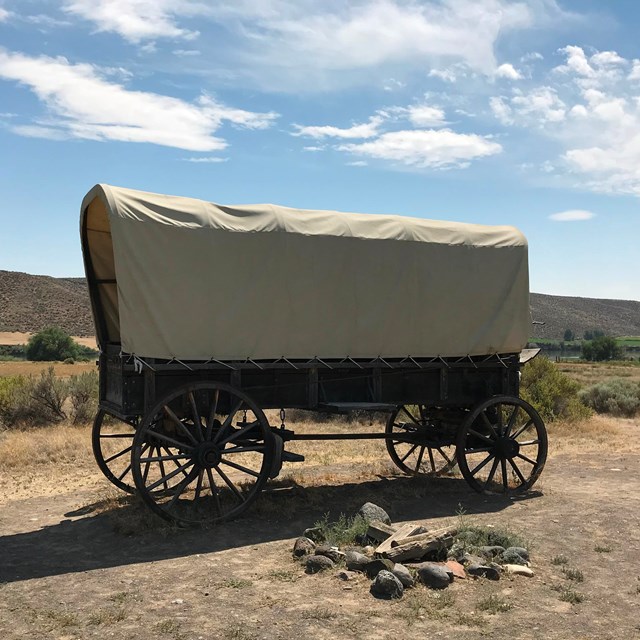Last updated: March 14, 2022
Article
First Year in Oregon, 1840-1869: A Narrative History
After traversing the roughly 2,000-mile Oregon Trail, overlanders arrived at their destination: the fertile and rain-soaked Willamette Valley. The first year in Oregon presented challenges for new arrivals: Where would they sleep? What would they eat? Could they count on anyone to help them? How might they work to earn food, clothing, or money?
This narrative history describes how overlanders survived their first year in Oregon and how the first-year experience evolved from 1840 to 1869. While many arrived in Oregon City in the 1840s, or in Portland in later years, they settled far and wide across the Willamette Valley, Umpqua Valley, Red River Valley, Clatsop Plains, and other parts of Oregon and Washington. They often spent their first winters in temporary accommodations with friends, relatives, or strangers willing to rent rooms, and they only later found land where they could build their own houses and live more permanently.
Some new arrivals found Oregon to be full of fertile land and immense opportunity, as Betsey Bayley wrote to her sister back in Ohio,
Oregon is the healthiest country I ever lived in; there is no prevailing disease, and many people come here for health. The climate is mild and pleasant, and the air pure and bracing. I have kept fresh meat for three weeks, good and fresh without salt. Chehalem Valley is a most beautiful place. It is surrounded with hills, mountains and beautiful groves. We live in full view of Mount Hood, the top of which is covered with eternal snow. The country abounds in almost all kinds of vegetation. It is one of the best wheat countries in the world. You can sow wheat any time of the year, and you are sure of a good crop. Vegetables do well; cabbage will grow all winter. I have seen heads of cabbage branch out from an old stalk that was three years old. The country produces almost all kinds of fruit – whortleberries, blackberries, thimbleberries, strawberries, etc. The first year we came here strawberries bloomed all winter, but in 1847 we had a hard winter; the snow laid on the ground for three weeks, but I did not think this is a hard winter, compared with Missouri or Ohio. In this country it scarcely ever snows, and if any snow falls at all it melts quickly. Men can work in thin shirt sleeves all winter. Oregon is settling very rapidly. People are flocking here from all parts of the world.1
Not all who arrived were pleased with what they found in the Willamette Valley. Decades of boosterism about Oregon had raised the expectations of some overlanders so high that the reality was a letdown.
Those who arrived in the Willamette Valley in the early 1840s encountered Kalapuyan and Chinookan people, Hudson’s Bay Company (HBC) employees, and retired fur traders and their families in Métis communities in the area that became known as French Prairie. There was little in the way of American infrastructure, and newcomers relied on HBC employees or Kalapuyan and Chinookan people to survive their first winter. Jesse A. Applegate, who was a child when he came to Oregon, described his family’s first few months in Oregon,
We learned to speak the Chinook Wa-Wa that winter. The mission children spoke it as habitually as they did their mother tongue. . . . There was one Indian who spoke both English and Chinook. he had a droll way of speaking in Chinook and then in English. He would say, “Nike tik-ek chuck,” “I want water,” “Nika hyas olo,” “I am very hungry.” “Potlatch tenas piah sap-po-lil,” “Give a little bread,” and so on. . . .2
As more and more American overlanders arrived to settle the Oregon and Washington Territories, the population makeup changed. After the United States and Britain settled the boundary between the two nations in 1846, the HBC vacated the region and businesses run by American settlers filled the void. The US government later forced Kalapuyan and Chinookan people to leave the Willamette Valley and gave away their lands to primarily White settlers, further tipping the scales in favor of White Americans.
White overlanders’ first year in Oregon became easier as American communities grew and established transportation networks, businesses, and social organizations. Those who could participate in Oregon’s territorial and then state legislature—mostly White men—passed discriminatory legislation, including a Black exclusion provision in the state constitution, miscegenation laws, and poll taxes on Black, Hawaiian, Chinese, and “mulatto” people. These laws made it difficult for non-White people to settle, work, or own land in Oregon. As the first year in Oregon became easier for White overlanders, they made it harder and harder for individuals of color to live in the state.
This article is a summary of the following research report:
First Year in Oregon: A Narrative History (1840–1869)
AUTHOR: Historical Research Associates, Inc.
DATE ACCEPTED: October 2021
1 Kenneth L. Holmes ed., Covered Wagon Women, Volume 1: Diaries and Letters from the Western Trails, 1840–1849
(Lincoln, NE: Bison Books, 1995), 37.
2 Jesse Applegate, A Day with the Cow Column in 1843: Recollections of My Boyhood (Chicago: Caxton Club, 1934), 124–25. Jesse A. Applegate was seven years old when he accompanied his family, including his father, Lindsay Applegate, and uncles Jesse and Charles Applegate, to the Oregon Country. His recollections of the journey were published ninety years later.


